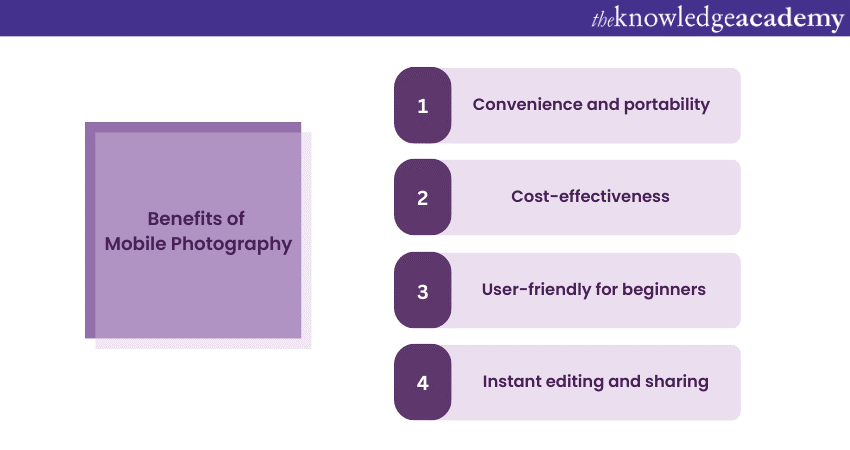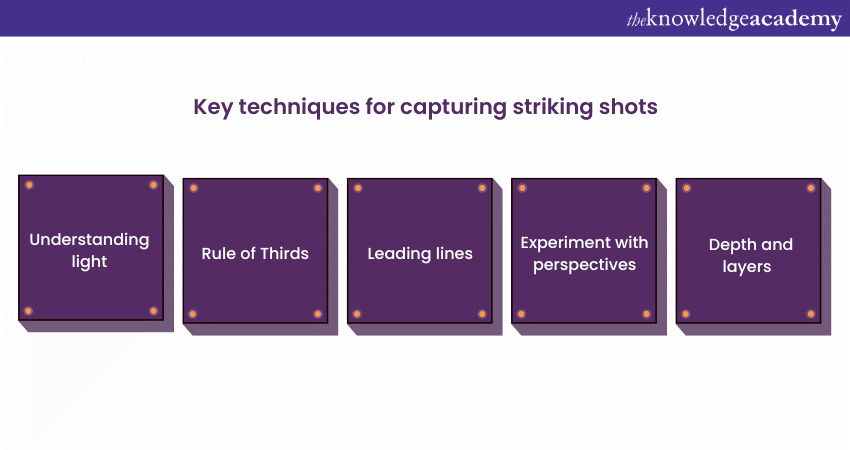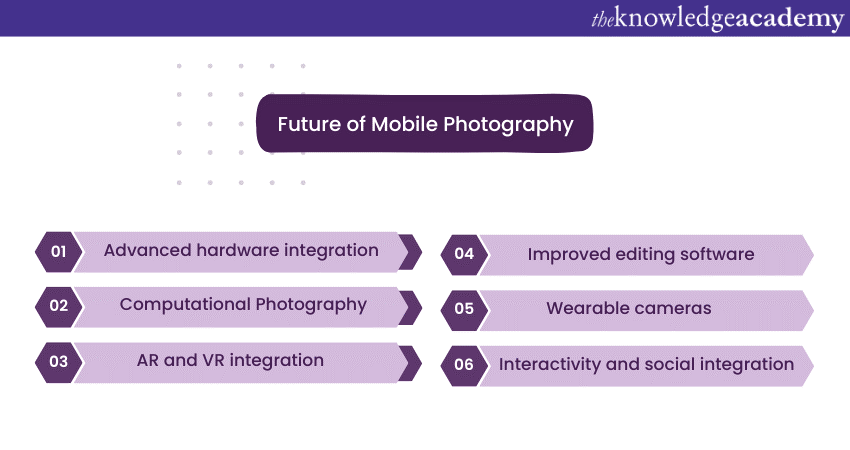We may not have the course you’re looking for. If you enquire or give us a call on +971 8000311193 and speak to our training experts, we may still be able to help with your training requirements.
We ensure quality, budget-alignment, and timely delivery by our expert instructors.

Are you an amateur Photographer looking for a big opportunity to showcase your skill but don’t have the means to do so? Well, Mobile Photography is a prominent solution to this problem. It has transformed the pockets of billions of people into treasure troves of memories, emotions, and stories.
With smartphones becoming increasingly sophisticated, these palm-sized gadgets are now a big rival to traditional cameras in terms of image quality and versatility. They have democratised the world of Photography, breaking down barriers and making the art form accessible to all, regardless of technical expertise. In this blog, you will learn about the intricacies surrounding Mobile Photography, its benefits and ways to overcome future challenges. Read on further to know more!
Table of Contents
1) What is Mobile Photography?
2) Benefits of Mobile Photography
3) Key techniques for capturing striking shots
4) Overcoming Mobile Photography challenges
5) The future of Mobile Photography
6) Conclusion
What is Mobile Photography?
Mobile Photography is the way of capturing images using a smartphone's built-in camera. This modern approach to Photography is distinguished by its spontaneity, accessibility, and the connection between the Photographer and the world around them. Unlike traditional Photography, which often requires bulky equipment and sometimes intricate setups, it thrives on simplicity.
It seamlessly integrates with the digital ecosystem. With just a few taps, photographs can be edited, enhanced, and shared across various platforms. This makes storytelling more immediate and impactful. This interconnectedness ensures a continuous exchange of ideas, techniques, and inspirations across borders and cultures.
Capture the world through a new lens with our Photography Masterclass .
Benefits of Mobile Photography
In this section, you'll learn about the several benefits of Mobile Photography:

1) Convenience and portability
The most apparent advantage is the convenience of having a camera always at hand. Unlike traditional bulky DSLR cameras, smartphones fit snugly in our pockets. This means you can always capture spontaneous moments, whether it's an unexpected reunion with an old friend, or a breathtaking sunset.
2) Cost-effectiveness
Purchasing a high-end camera, along with its lenses and accessories, can burn a significant hole in one's pocket. Smartphones, on the other hand, serve multiple functions beyond just Photography, offering value for money. Additionally, with the rapid advancements in smartphone camera technology, even mid-range phones today come equipped with commendable cameras.
3) User-friendly for beginners
Diving into the world of DSLRs can be daunting for novices. It has several modes, and terminologies. Mobile cameras, with their intuitive interfaces, simplify this. Features like Auto mode, HDR, and Portrait provide you with the capability to shoot high-quality photos without delving into the nitty-gritty of manual settings.
4) Instant editing and sharing
The synergy between Mobile Photography and social media is undeniable. With several editing apps at your fingertips, from Snapseed to VSCO, you can edit and post-process your shots immediately. This allows for real-time sharing on platforms like Instagram, Facebook, or Twitter, facilitating instant feedback and interaction with a global audience.
5) Exploration of new perspectives
The unobtrusive nature of smartphones encourages photographers like you to experiment. They can get into tight spaces, shoot from unique angles, or even play with reflections on the phone screen. The opportunities for creativity are boundless.
6) Expanding the photographic community
The accessibility of Mobile Photography has expanded the global community of Photographers. Platforms like Instagram host challenges, and hashtags like #ShotOniPhone or #MobilePhotography create inclusive spaces where professionals and amateurs alike can showcase their work, learn, and grow.
7) Integration with advanced technologies
Modern smartphones come equipped with Artificial Intelligence (AI) and computational Photography features. These technologies aid in recognising scenes, optimising settings, and even enhancing shots post-capture. Features like Night mode help you to capture impressive low-light Photography.
8) Environmental adaptability
Extreme conditions like rain or dust might deter you from using your high-end gear. However, there are several smartphones available in the market that are both water and dust resistance. This adaptability ensures that no moment is missed.
9) Encouraging mindfulness and observation
Given the ease of Mobile Photography, you can be more observant of your surroundings. You can always be on the lookout for a captivating frame or a story waiting to be told. This heightened sense of awareness can make everyday life seem more vibrant and intriguing.
Turn your hobby into profession with our course on Hobbies & Interests .
Key techniques for capturing striking shots
By employing specific techniques and understanding some fundamental principles of Photography, you can elevate your mobile shots from good to exceptional. Here are some key techniques to get you started:

1) Understanding light:
a) Natural light: The golden hours—shortly after sunrise and before sunset—offer the softest and most flattering light. This magical light casts a warm glow, reducing harsh shadows and adding depth to images.
b) Artificial light: Play with light sources such as streetlights, neon signs, or even candles. These can introduce interesting colours and contrasts to your images.
c) Avoiding harsh midday light: Direct overhead sun can produce strong shadows and overexposed highlights. If shooting in these conditions, look for shade or use it as an opportunity to capture silhouette images.
2) Rule of Thirds
Imagine your frame divided into nine equal rectangles by two vertical and two horizontal lines. Positioning subjects or key elements of your composition at the intersections of these lines creates a more balanced and visually engaging photo. The objective here is to use two thirds of the entire frame to represent the subject.
3) Leading lines
Use natural or architectural lines to guide the viewer's eye towards the main subject or a vanishing point. Roads, pathways, railings, or even the horizon can serve as effective leading lines.
4) Experiment with perspectives
Don’t just shoot from the eye level. Try different angles—shoot from down low, up high, or even from a bird's-eye or worm’s-eye view. This can introduce a fresh take on familiar subjects.
5) Depth and layers
Adding layers to your composition—something in the foreground, middle ground, and background—can give your image depth, making it more three-dimensional and engaging.
6) Focus and blur
Tap on your smartphone screen to focus on a particular subject. Many smartphones offer a 'portrait mode' that blurs the background, giving a professional-looking shallow depth of field.
For moving subjects, use the 'burst mode'. This captures multiple frames in quick succession, ensuring you get a sharp image.
7) Symmetry and patterns
Human eyes are drawn to symmetry and patterns. Whether it's the reflection in a lake, architectural designs, or repetitive patterns in nature, using them can make your images more aesthetically pleasing.
8) Framing
Use natural frames, like windows, doorways, or tree branches, to enclose your subject. This not only draws attention but also adds context to the shot.
9) Minimalism
Sometimes, less is more. An uncluttered composition with a clear subject and negative space can create a powerful visual impact.
10) Post-processing
While it's crucial to get the best shot in-camera, don't shy away from using editing apps. Adjusting exposure, contrast, sharpness, or even cropping can enhance your images. But remember, moderation is key.
11) Stay steady
Ensure your shots aren't blurred from hand movement. If you're shooting in low light or capturing a long exposure, stabilise your phone against a solid surface or use a mobile tripod.
12) Continuous learning
The Photography world is ever evolving. Stay updated with new features and techniques, attend workshops, and engage with online Mobile Photography communities. Learning is a never-ending journey.
Overcoming Mobile Photography challenges
While the craft of taking pictures from a mobile is widely celebrated for its accessibility and convenience, it is not without its set of challenges. From hardware limitations to unfavourable environments, mobile Photographers face an array of obstacles. However, with a bit of know-how, these challenges can be overcome, allowing for stunning photos that belie their smartphone origins. Let's delve into some common challenges and strategies for overcoming them.
1) Limited hardware
a) Challenge: Unlike DSLRs or mirrorless cameras, smartphones don't have interchangeable lenses. Their smaller sensors can sometimes result in less detailed images, especially in challenging light conditions.
b) Solution: Make the most of what you have. Use clip-on lenses to expand your range. Wide-angle, macro, and fisheye lenses are available for mobile devices. Use apps that allow for RAW capture, ensuring maximum detail and flexibility in post-processing.
2) Low light and night Photography
a) Challenge: Mobile cameras can struggle in low light, leading to grainy, blurry images.
b) Solution: Use the in-built night mode available in many smartphones, which takes multiple exposures and combines them for a brighter, clearer photo. A tripod or a steady surface can also be invaluable in these situations, reducing camera shake. Additionally, editing apps can help reduce noise in post-production.
3) Overreliance on digital zoom
a) Challenge: Digital zoom can deteriorate image quality, leading to pixelated photos.
b) Solution: Instead of zooming in, try moving closer to your subject if possible. If you must zoom, do so minimally and use editing tools to crop and sharpen your image later.
4) Storage constraints
a) Challenge: High-resolution photos and videos can quickly consume a phone's storage.
b) Solution: Regularly back up your images to cloud services like Google Photos or iCloud. External storage devices and SD cards (if your device supports them) can also help. Periodically clearing out unwanted photos can free up space.
5) Battery drain
a) Challenge: Using the camera, especially with apps, GPS, and data on, can rapidly drain your phone's battery.
b) Solution: Carry a portable power bank to ensure you don't run out of juice in the middle of a shoot. Turn off unnecessary apps and services while shooting. Some photographers even carry a dedicated smartphone just for Photography to ensure they always have a working phone.
6) Dynamic range limitations
a) Challenge: Mobile cameras can sometimes struggle with high contrast scenes, where bright areas get overexposed, and shadows become too dark.
b) Solution: Use the High Dynamic Range (HDR) mode, which captures multiple exposures and merges them. This can help balance out the highlights and shadows. Manual exposure controls available in professional camera apps can also assist in achieving the desired exposure.
7) Motion blur
a) Challenge: Capturing fast-moving subjects can sometimes result in blurry images.
b) Solution: Use burst mode to take a rapid sequence of shots, increasing the chance of getting a clear photo. Some smartphones also have dedicated sports or action modes that optimise settings for fast capture.
8) Composition challenges
a) Challenge: With the ease of Mobile Photography, one might overlook compositional techniques, leading to less impactful photos.
b) Solution: Always be mindful of your composition. Follow principles like the rule of thirds, leading lines, and symmetry. Take your time framing the shot, and don’t hesitate to take multiple shots from different angles.
9) Over-editing
a) Challenge: With a plethora of editing apps and filters available, there's a temptation to over-edit, leading to unnatural-looking images.
b) Solution: Less is often more in editing. Adjust just enough to enhance the image's natural beauty without making it look artificial. It's crucial to maintain the authenticity of the shot.
10) Distractions and photobombing
a) Challenge: Especially in busy areas, unwanted elements or people can enter your frame.
b) Solution: Be patient. Wait for the right moment when distractions are minimal. Alternatively, use editing tools to remove unwanted elements in post-production. Another creative approach is to incorporate these elements intentionally, making them a part of the story.
11) Lens flare and glare
a) Challenge: Shooting against a light source, especially the sun, can result in lens flare or glare.
b) Solution: Use your hand or an object to shield the lens. Sometimes, changing your angle slightly can eliminate the flare. However, if used creatively, lens flare can add an artistic touch to your photos.
12) Over-dependence on auto mode
a) Challenge: While auto mode is convenient, it might not always yield the best results, as the camera makes assumptions about what you're trying to capture.
b) Solution: Familiarise yourself with your smartphone's manual or pro mode. This allows control over settings like ISO, shutter speed, and focus, enabling you to adapt to various situations better.
The future of Mobile Photography
The discipline, once a secondary option for many, has rapidly grown into a primary mode of capturing moments for millions across the globe. With constant technological advancements, the boundary between smartphones and traditional cameras continues to blur. As we look ahead, the future presents an intriguing blend of possibilities that are set to reshape how we perceive and interact with this art form.

1) Advanced hardware integration: In the coming years, we can expect to see even more powerful camera sensors integrated into our smartphones. Multiple-camera setups is already a trend, and will evolve further. This will also provide you with a range of focal lengths, from ultra-wide to telephoto, all in one device.
2) Computational Photography: One of the major differentiators between smartphones and traditional cameras is the ability of the former to process images using advanced algorithms. We're already seeing the beginnings of this with features like Night Mode and Super Resolution. Future smartphones will lean even more heavily on Computational Photography.
3) AR and VR integration: Augmented Reality (AR) and Virtual Reality (VR) technologies are increasingly becoming mainstream. These can offer immersive viewing experiences. Imagine capturing a scene and then, using VR, stepping into that moment, reliving it in a 360-degree space. The lines between Photography, video, and immersive experiences will continue to blend, offering novel ways to document reality.
4) Improved editing software: While there are already powerful editing tools available for mobile devices, the future will bring even more sophisticated software, rivalling desktop applications. This will provide photographers with the ability to make detailed edits, retouching, and enhancements directly on their mobile devices.
5) Wearable cameras: The concept of wearable tech, like smart glasses, is gradually gaining traction. In the future, we may see the integration of high-quality cameras into these devices. This will allow for a more spontaneous and hands-free form of Photography.
6) Interactivity and social integration: As social media platforms evolve, the integration of Mobile Photography with these platforms will deepen. We may witness a future where photos are not just static images but interactive mediums, containing embedded videos, sounds, or even tactile feedback.
7) Sustainable technologies: As the global community becomes more environmentally conscious, we can anticipate a push towards more sustainable camera technologies. This could manifest in longer-lasting batteries, eco-friendly materials, and devices designed for longevity rather than rapid obsolescence.
8) Democratisation of Photography: One of the most profound impacts of Mobile Photography has been its democratising effect. This involves allowing individuals from diverse backgrounds to engage with Photography.
9) Depth in portraiture: With advancements in depth-sensing technologies, this discipline will offer more nuanced and detailed portraits. Features like adjustable background blur, will mature, providing results that rival professional cameras with high-end lenses.
10) Drones and aerial Mobile Photography: As drones become more compact and affordable, integrating mobile technology, we'll see an increase in aerial Photography. Your smartphone could potentially become the control centre for capturing breathtaking aerial shots.
Conclusion
The trajectory of Mobile Photography is unmistakably upward. It is merging technology with artistry. As advancements unfold, they promise to redefine not just how you capture, but also how you experience moments. Amidst all the innovations, the main purpose of ensuring photographs echo genuine emotions and narratives.
Craft your cinematic vision with our Filmmaking Masterclass .
Upcoming Business Skills Resources Batches & Dates
Date
 Photography Course
Photography Course
Fri 28th Feb 2025
Fri 4th Apr 2025
Fri 27th Jun 2025
Fri 29th Aug 2025
Fri 24th Oct 2025
Fri 5th Dec 2025






 Top Rated Course
Top Rated Course



 If you wish to make any changes to your course, please
If you wish to make any changes to your course, please


